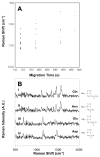Online SERS detection of the 20 proteinogenic L-amino acids separated by capillary zone electrophoresis
- PMID: 25268706
- PMCID: PMC4249764
- DOI: 10.1039/c4an01177e
Online SERS detection of the 20 proteinogenic L-amino acids separated by capillary zone electrophoresis
Abstract
A sheath-flow surface-enhanced Raman scattering (SERS) detector is demonstrated to provide chemical information enabling identification of the 20 proteinogenic L-amino acids separated by capillary zone electrophoresis (CZE). Amino acids were used to illustrate the chemical specificity of SERS detection from structurally related molecules. Analysis of the SERS electropherograms obtained from the separation and sequential online detection of six groups of structurally related amino acids shows that our sheath-flow SERS detector is able to resolve the characteristic Raman bands attributed to the amine, carboxyl, and side chain constituents. The results demonstrate the chemical information available from our detector and also provide insight into the nature of the analyte interaction with the silver SERS substrate. The spectra extracted from the SERS electropherogram of a mixture containing the 20 proteinogenic L-amino acids show unique signatures characteristic to each amino acid, thus enabling identification. The results presented here demonstrate the potential of this sheath-flow SERS detector as a general purpose method for high throughput characterization and identification following separations of complex biomolecular mixtures.
Figures







References
-
- Dovichi NJ, Hu S. Current Opinion in Chemical Biology. 2003;7:603–608. - PubMed
-
- Jorgenson JW, Lukacs KD. Science. 1983;222:266–272. - PubMed
-
- Ohno K, Tachikawa K, Manz A. Electrophoresis. 2008;29:4443–4453. - PubMed
-
- Squires TM, Quake SR. Reviews of Modern Physics. 2005;77:977–1026.
-
- Fiorini GS, Chiu DT. Biotechniques. 2005;38:429–446. - PubMed
Publication types
MeSH terms
Substances
Grants and funding
LinkOut - more resources
Full Text Sources
Other Literature Sources
Miscellaneous

